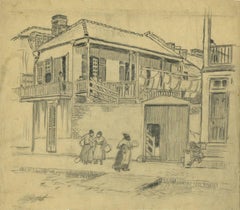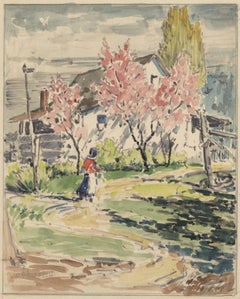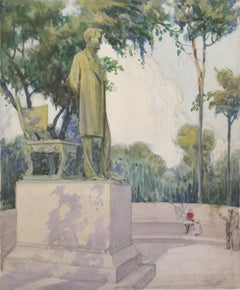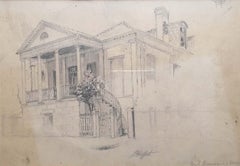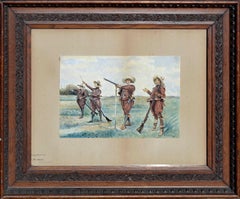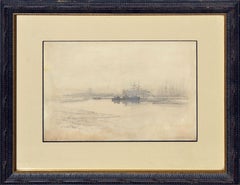Louis Oscar Griffith Landscape Drawings and Watercolors
to
4
Overall Width
to
Overall Height
to
1
3
2
1
4
2
2
1
1
2
2
2
2
1
15
143
125
66
60
1
4
Artist: Louis Oscar Griffith
Preliminary Drawing for the color aquatint "New Orleans, Street Gossip"
By Louis Oscar Griffith
Located in Fairlawn, OH
Preliminary Drawing for the color aquatint "New Orlaens, Street Gossip"
Signed by the artist in pencil lower left
Graphite on tracing paper, 1916-1917
An impr...
Category
1910s American Impressionist Louis Oscar Griffith Landscape Drawings and Watercolors
Materials
Graphite
Spring Landscape with house and figure
By Louis Oscar Griffith
Located in Fairlawn, OH
Spring Landscape with house and figure
A preliminary watercolor for a color aquatint, illustrated on line, title unknown
Signed lower left in block letters (see photo)
Watercolor and...
Category
1920s American Impressionist Louis Oscar Griffith Landscape Drawings and Watercolors
Materials
Watercolor
Standing Lincoln: The Man, Lincoln Park, Illinois
By Louis Oscar Griffith
Located in Fairlawn, OH
Standing Lincoln: The Man, Lincoln Park, Illinois
Watercolor and graphite on paper , c. 1895
Signed in script lower right (see photo)
The scene depicts the Augustus Saint-Gaudens bro...
Category
1890s American Impressionist Louis Oscar Griffith Landscape Drawings and Watercolors
Materials
Watercolor
Beauregard House, New Orleans
By Louis Oscar Griffith
Located in New Orleans, LA
Louis Oscar Griffith (1875-1956) was an American painter known for his etchings, paintings, and aquatints of landscapes, especially scenes of Brown County, Indiana, New Orleans, LA and Texas. Griffith was born in Indiana in 1875 but later moved to Dallas, TX with his family. As a teen, he took art lessons with acclaimed landscape artist, Frank Reaugh...
Category
1910s Impressionist Louis Oscar Griffith Landscape Drawings and Watercolors
Materials
Paper, Graphite
Related Items
"Arquebusiers En Manoeuvre", After Marchetti
Located in Soquel, CA
Figurative landscape of four infantrymen in formation with their long arquebus guns by Adolphe Ancker (Dutch, 19th Century), after Marchetti. Signed and dated "Adolph Ancker 1888" lo...
Category
1880s American Impressionist Louis Oscar Griffith Landscape Drawings and Watercolors
Materials
Watercolor, Pencil, Paper
Late 19th Century Boats at San Francisco Port Seascape Drawing
By Raymond Dabb Yelland
Located in Soquel, CA
San Francisco moorings, a late 19th century double-sided pencil sketch by Raymond Dabb Yelland (American, 1848 - 1900), 1987. Signed "R.D. Yelland" lower right. Dated "87" lower left. Drawing on both sides of paper. Wood frame. Image size, 8.5"H x 12"L.
A master marine painter, Yelland painted in Gloucester Harbor. He sailed to San Francisco in 1874 to take a teaching position in art at Mills College in Oakland. From 1877 to 1894, he taught at the California School of Design. He was a decisive influence on a younger generation of California artists.
Full Bio:
Raymond Dabb Yelland was born in London, England on February 2, 1848. At the age of three, he immigrated with his family to New York City where he was raised and attended public schools. By the age of twelve, he had settled on art as a career.
He was born as Raymond Dabb, but due to the negative connotation of his name, his mother's maiden name, Yelland, was added. After serving under Sheridan in the Federal Army during the Civil War, Yelland attended Pennington Seminary in New Jersey. He studied art at the National Academy of Design from 1869 to 1871 with Page and Brevoort, and then taught at the Academy for one year.
With his new bride, he sailed around the Horn in 1874 to San Francisco where he would assume the position of an art instructor at Mills College in Oakland. In 1877, he traveled to England, and later continued his studies in Paris with Luc Oliver Merson. Upon his return to California, Yelland became assistant director of the San Francisco School of Design, and in 1888, assumed its directorship. While at that school, he also taught at the University of California, Berkeley, for many years. His many pupils included Homer Davenport, Alexander Harrison...
Category
1880s American Impressionist Louis Oscar Griffith Landscape Drawings and Watercolors
Materials
Paper, Pencil
$2,295
H 15 in W 19 in D 1 in
Amarillo By Morning - Desert Landscape Nature Painting on Handmade Paper
Located in Los Angeles, CA
Michaela Jean is an accomplished painter, devoted gardener, and mother from Southern California (USA). Her lifelong passion for art and nature began in childhood, inspired by her gra...
Category
2010s Impressionist Louis Oscar Griffith Landscape Drawings and Watercolors
Materials
Ink, Acrylic, Watercolor, Color Pencil, Mixed Media, Handmade Paper
1910 Colorado Plein Air Landscape Sketch – Mountains, Valley & Field Drawing
By Charles Partridge Adams
Located in Denver, CO
This original circa 1910 graphite landscape drawing is a rare and intimate work by renowned Colorado artist Charles Partridge Adams (1858–1942), celebrated for his mastery of the Ame...
Category
1910s American Impressionist Louis Oscar Griffith Landscape Drawings and Watercolors
Materials
Graphite
$1,450
H 11.5 in W 16.5 in D 0.75 in
1924 Colored Pencil Drawing by George E Burr, Arizona Desert Storm Landscape
By George Elbert Burr
Located in Denver, CO
This vintage, original colored pencil drawing titled Untitled (Storm over Desert Landscape, Arizona) was created in 1924 by celebrated American artist George ...
Category
Early 20th Century American Impressionist Louis Oscar Griffith Landscape Drawings and Watercolors
Materials
Paper, Color Pencil
George Elbert Burr1924 Colored Pencil Drawing by George E Burr, Arizona Desert Storm Landscape, 1924
$3,450
H 17 in W 20.25 in D 1 in
1880s Southwestern Desert Landscape Drawing - Morning Near Arizona, Summer
By George Elbert Burr
Located in Denver, CO
This original color pencil drawing, Morning Near Arizona (1888), is a captivating depiction of a Southwestern desert landscape by renowned artist George Elbert Burr (1859-1939). Crea...
Category
1880s American Impressionist Louis Oscar Griffith Landscape Drawings and Watercolors
Materials
Color Pencil
$1,590 Sale Price
40% Off
H 17 in W 20.25 in D 1 in
"Road Warriors" (2012) By Susie Hyer, Original Graphite Drawing on Paper
Located in Denver, CO
"Road Warriors" (2012) By Susie Hyer is an original handmade graphite drawing on paper that depicts a road with cars in the distance, and mountains in the background. This piece meas...
Category
2010s Impressionist Louis Oscar Griffith Landscape Drawings and Watercolors
Materials
Paper, Graphite
1940s Netting the Catch
By Walter P. Taylor
Located in Soquel, CA
Expressive watercolor figurative of fisherman pulling in the nets by Walter P. Taylor (American, 20th Century). Signed "W.P. Taylor U.S.N.R.'45 (for United States Naval Reserve)" low...
Category
1940s American Impressionist Louis Oscar Griffith Landscape Drawings and Watercolors
Materials
Paper, Watercolor
'Storm Clouds (Arizona)' — Early 20th-Century American Impressionism
By Albert Groll
Located in Myrtle Beach, SC
Albert Lorey Groll, 'Storm Clouds (Arizona)', graphite on paper, c. 1914. Signed in pencil, in the image, lower left. A fine spontaneous rendering on heavy buff, wove paper, with margins (1 1/2 to 2 inches); slight toning at the sheet edges, in good condition. With a pen and ink landscape drawing, verso.
Image size 7 5/8 x 10 inches; sheet size 10 3/4 x 13 5/8 inches. Matted to museum standards, unframed.
Provenance: Ex. collection Kennedy Galleries, New York.
ABOUT THE ARTIST
Albert Lorey Groll (1866-1910) was born in New York in 1866, the son of a pharmacist immigrant from Darmstadt, Germany. During his early years, he traveled to Europe to study at the Royal Academy of Fine Arts in Munich under Nicholas Gysis and Ludwig von Löfftz. He further pursued his studies in London and at the Royal Academy of Fine Arts in Antwerp, Belgium. Groll returned to New York in 1895 and moved from figure to landscape painting while expanding his interests to printmaking.
In 1904 Groll made the first of several trips to the American Southwest, traveling to Arizona with ethnographer Stewart Culin of the Brooklyn Museum. Later he went to New Mexico with his friend, the artist and illustrator William Robinson Leigh (see our 1stDibs listing no. LU53239015112 ). He focused on impressionistic scenes of Native American lands. The Laguna Pueblo people admired Groll's paintings, honoring him with the name "Chief Bald Head Eagle Eye."
Groll kept a studio in the Gainsborough Studios in Manhattan and won several awards for his work in Arizona and New York, including the Salmagundi Club Shaw Prize in 1904 and a gold medal at the Pennsylvania Academy of Fine Arts in 1906. He was also awarded the George Inness gold medal from the National Academy of Design in 1912 for his painting of Lake Louise in the Canadian Rockies.
In 1910 he was elected into the National Academy of Design and, in 1919, an associate member of the Taos Society...
Category
1910s American Impressionist Louis Oscar Griffith Landscape Drawings and Watercolors
Materials
Pencil
1930's Milford, CT Landscape -- First Church of Christ Congregational
Located in Soquel, CA
1930's watercolor figurative landscape depicting the First Church of Christ Congregational in Milford, Connecticut by J. Nolan of Providence, Rhode Island (American, 20th Century). S...
Category
1920s American Impressionist Louis Oscar Griffith Landscape Drawings and Watercolors
Materials
Watercolor, Laid Paper
$695
H 11.63 in W 25.63 in D 0.75 in
Crinolones sur la Plage - Impressionist Figurative Watercolor by Eugene Boudin
By Eugène Louis Boudin
Located in Marlow, Buckinghamshire
Signed and dated watercolour and pencil on paper by impressionist painter Eugene Boudin. The work depicts elegantly dressed people enjoying a day on the beach. Some women are resting...
Category
1860s Impressionist Louis Oscar Griffith Landscape Drawings and Watercolors
Materials
Paper, Watercolor, Pencil
$25,126
H 14.5 in W 17.5 in
1950s Denver Skyline Painting – Graphite & Watercolor Colorado Cityscape Art
Located in Denver, CO
A captivating midcentury cityscape titled "Denver Skyline", this original 1950s watercolor and graphite painting offers a rare industrial-era view of lower downtown Denver, Colorado....
Category
1950s American Impressionist Louis Oscar Griffith Landscape Drawings and Watercolors
Materials
Watercolor, Graphite
$1,950
H 17.5 in W 21.5 in D 0.75 in
Louis Oscar Griffith landscape drawings and watercolors for sale on 1stDibs.
Find a wide variety of authentic Louis Oscar Griffith landscape drawings and watercolors available for sale on 1stDibs. You can also browse by medium to find art by Louis Oscar Griffith in graphite, paint, pencil and more. Much of the original work by this artist or collective was created during the 20th century and is mostly associated with the Impressionist style. Not every interior allows for large Louis Oscar Griffith landscape drawings and watercolors, so small editions measuring 8 inches across are available. Customers who are interested in this artist might also find the work of Greta Allen, James March Phillips, and Eve Nethercott. Louis Oscar Griffith landscape drawings and watercolors prices can differ depending upon medium, time period and other attributes. On 1stDibs, the price for these items starts at $1,500 and tops out at $2,000, while the average work can sell for $1,675.
